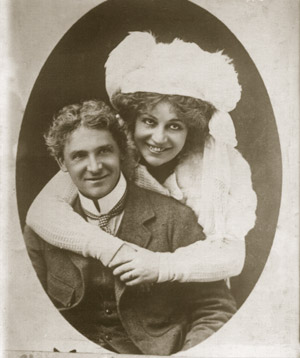When referring to fit-up theatre it might be as well to define it and the following quotation seems to suit admirably. Fit up:
‘A name given in the 18th and 19th centuries to small bands of actors, often composed largely of members of a single family, who travelled with plays to back water villages. They customarily performed in makeshift theaters, using barns, store-porches or any other available site'Although this is a quotation of American fit-up, the situation was much the same in the British travelling theatre later, though, as there were no store porches in Britain, the company used any cover available, such as village halls etc.
According to Phyllis Hartnoll, fit-up travelling theatres in England grew out of the fairs during the 17th Century such as Saint Bartholomew, Southwark and Smithfield.
There is also a reference to 'fit-up' theatre as far back as Elizabeth I's reign As Alec Clunes states in his book:
'The first eighteen years of Elizabeth's reign, public performances had taken place in Inn Yards played on a 'fit-up' platform on trestles.'These itinerant players had through the ages, been regarded very scathingly as will be seen from this quotation from Strutt:
'a writer of that time is very severe against them, calling them jugglers, scofferes, jeasters(sic) and players, and ranks them with the lowest of the lowest and most vicious of mankind!'
Which reputation remained with them to some extent until the late 19th century with the knighting of Henry Irving though they were then referred to as 'vagrants' and 'vagabonds' which name was still in vogue until abolished by the Theatre Act, as late as l968.
The company under discussion would have been outraged had they been regarded as anything other than a first class, hard working company of actors, as will be seen from the forthcoming account of 'Madame Ada Lauderdale and her talented theatrical Company.
A Short History of Ada
Ada Mabel Lauderdale, Loncraine, Beckett, Preece, known professionally as 'Madam Ada Lauderdale' was the owner and manager of her own 'Fit-Up Company' which she ran herself until the time of her death in 1935.She had been part of and had then inherited the company from her mother, Elizabeth (Lizzie) Linington who ran it in the mid and late nineteenth century, and who was married to Frederick Lorton Loncraine, known as Fred Beckett.
Ada was married to Stanley Pratt (he adopted the name of Beckett) her first husband and subsequently to her second husband, Carl Sisto Preece.
She had three sons and one daughter by her first husband. Also five sons and two daughters by her second husband. All these children, whether boys or girls, followed the family tradition by playing at some period in their younger lives, the part of 'Little Willie' in 'East Lynne' and 'Little Eva' in 'Uncle Tom's Cabin'. The girls graduated to the part of Topsy, again in 'Uncle Tom's Cabin' - until they were grown women. The boys played their parts until puberty. They would also play parts of any other young people.
The company, until the children grew of a capable age, was formed of any suitable actor or actress applying. (One member was Michael Redgrave's grandmother who was usually referred to as 'Grannie Scudamore' - she remained with the company for some time)When adult, the three eldest boys of the first marriage, left to make their own way, one, Henry to become 'a fine actor' as Michael Redgrave referred to him in his book, "In My Mind's Eye". {Henry married Mabel Scudamore, Michael Redgrave's aunt). Two of them toured their own 'fit-up' companies which existed for several years, though under different names.
Apart from Ada, the company comprised eleven adults - Carl, their three eldest sons, with their wives, and the two daughters with their husbands, also two teen-age boys. Any progeny of the married people were put out to nurse until of an age to be useful.
Ada's company toured the villages of England and Wales and was most successful.
copyright©IT4theArty 2016